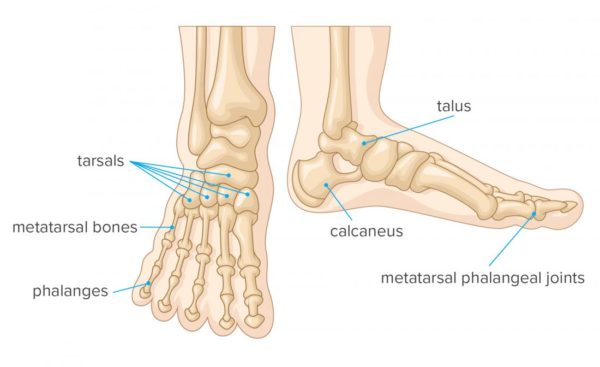Foot Pain
The foot’s complex structure consists of 26 bones, 33 joints, 107 ligaments, and 19 muscles. The bones fall into three categories: tarsal bones, metatarsal bones, and phalanges.
tarsal bones are a group of seven bones that make up the rear section of the foot. It connects with the tibia and fibula bones in the lower leg.
metatarsal bones are a group of five tubular bones in the middle of the foot. They connect to the tarsal bones and the phalanges.
phalanges are the bones in the toes. The second to fifth toes each contain three phalanges. The big toe contains only two phalanges.

As foot pain is a very common problem in children and adults, it is often challenging for doctors to assess the underlying cause. Where the pain presents itself and how it feels offers clues, but symptoms alone may not be enough to secure a diagnosis.
How is foot pain diagnosed?
A physiotherapist will ask you the following questions to determine diagnosis and treatment options:
- Where exactly is the pain located?
- Is the pain in one foot or both?
- Do you get pins and needles in your feet?
- What does the pain feel like? Is it dull or sharp?
- Is the pain only when walking or at resting periods too?
- Is the pain constant or intermittent?
- Are you limping?
- What makes your pain worse and what makes it feel better?
- How does it affect your day to day activities?
- How far can you walk before you need to rest?
- Does your foot give way on you at all?
- Do you have any pain in your back, hip, or knee?
- Do certain shoes make it feel better or worse?
- Have you tried wearing insoles? Do they help your symptoms?
A physical examination will help your physiotherapist to determine why you are experiencing foot pain. If the pain does not go away after a few physiotherapy sessions, they may refer you for an X-ray or MRI scan to assist with diagnosis and a further treatment plan.
Possible causes of foot pain:
- Plantar fasciitis
- Ligamentous sprain e.g. medial and lateral ligaments of the ankle
- Muscular strain e.g. tendocalcaneous rupture
- Osteoarthritis
- Tendinitis e.g. tibialis posterior, tibialis anterior, tendoachilles
- Fracture
- Flat Feet
- Bunions
- Gout
- Hammer Toe
- Rheumatoid arthritis
- Hypermobility
- Peripheral neuropathy
How to treat foot pain?
Treatment will depend on your physiotherapist’s observation. Suggested treatments include:
- Heat therapy
- Ice therapy
- Physiotherapy
- Pain medication
- Rest and activity medication
- Foot brace for support
- Orthotics/insoles in your shoes
How we can help your foot pain
We will do whatever we can to get you on the fastest route to recovery. Some of the treatment methods we use include:
- Mobilisations
- Strengthening exercises
- Myofascial trigger point release
- Pilates
- Cross-friction massage
- Stretching and range of movement exercises
- Acupuncture
- Functional exercises
- Taping
